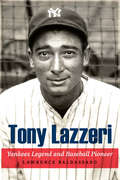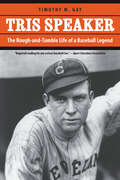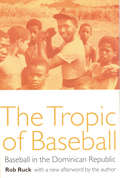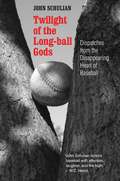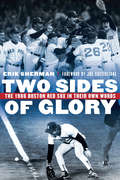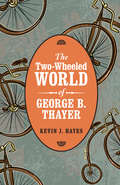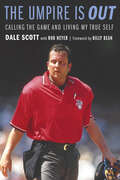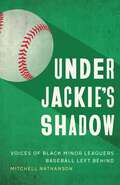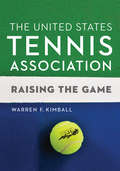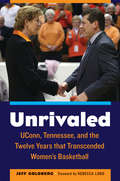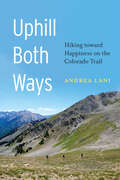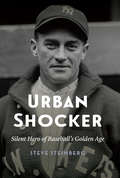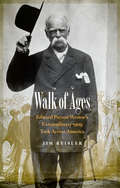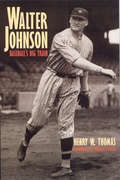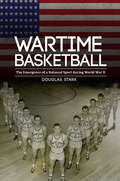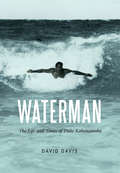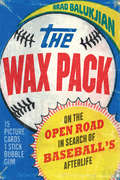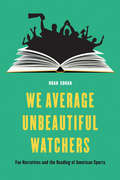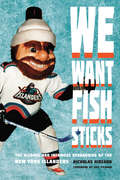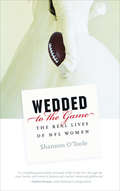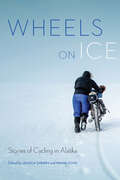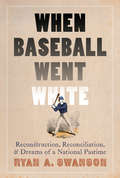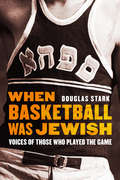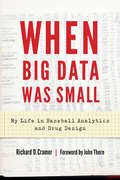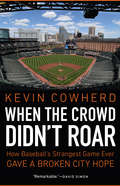- Table View
- List View
Tony Lazzeri: Yankees Legend and Baseball Pioneer
by Lawrence BaldassaroBefore there was Joe DiMaggio, there was Tony Lazzeri. A decade before the &“Yankee Clipper&” began his legendary career in 1936, Lazzeri paved the way for the man who would become the patron saint of Italian American fans and players. He did so by forging his own Hall of Fame career as a key member of the Yankees&’ legendary Murderers&’ Row lineup between 1926 and 1937, in the process becoming the first major baseball star of Italian descent. An unwitting pioneer who played his entire career while afflicted with epilepsy, Lazzeri was the first player to hit sixty home runs in organized baseball, one of the first middle infielders in the big leagues to hit with power, and the first Italian player with enough star power to attract a whole new generation of fans to the ballpark. As a twenty-two-year-old rookie for the New York Yankees, Lazzeri played alongside such legends as Babe Ruth and Lou Gehrig. He immediately emerged as a star, finishing second to Ruth in RBIs and third in home runs in the American League. In his twelve years as the second baseman for Yankee teams that won five World Series, he was their third-most productive hitter, driving in more runs than all but five American Leaguers, and hitting more home runs than all but six. Yet for all that, today Lazzeri is a largely forgotten figure, his legacy diminished by the passage of time and tarnished by his bases-loaded strikeout to Grover Cleveland Alexander in Game Seven of the 1926 World Series, a strikeout immortalized on Alexander&’s Hall of Fame plaque. Tony Lazzeri reveals that quite to the contrary, he was one of the smartest, most talented, and most respected players of his time, the forgotten Yankee who helped the team win six American League pennants and five World Series titles.
Tris Speaker: The Rough-and-Tumble Life of a Baseball Legend
by Timothy M. GayA three-time World Series winner and an early inductee into the Hall of Fame, lauded by Babe Ruth as the finest defensive outfielder he ever saw and described as "perfection on the field" by the great Grantland Rice, Tris Speaker enjoys the peculiar distinction of being one of the least-known legends of baseball history. Tris Speaker: The Rough-and-Tumble Life of a Baseball Legend is the first book to tell the full story of Speaker&’s turbulent life and to document in sharp detail the grit and glory of his pivotal role in baseball&’s dead-ball era. Playing for the Boston Red Sox and the Cleveland Indians in the early part of the twentieth century, Tris &“Spoke&” Speaker put up numbers that amaze us even today: his record for career doubles—792—may never be approached, let alone broken. Tris Speaker explores the colorful life behind the statistics, introducing readers to a complex and contradictory Texan whose cowboy mentality never left him as he brawled his way through two decades in the big leagues. Speaker&’s career put him in the company of Ty Cobb and Christy Mathewson, Shoeless Joe Jackson and Honus Wagner, and in describing it Timothy M. Gay gives a rousing account of some of the best baseball ever played—and some of the darkest moments that ever tainted a game and hastened the end of a career. His four years of research on Speaker unearthed a document that suggests that cheating induced by gambling was far more widespread in early baseball than officials have acknowledged. Gay&’s book captures the bygone spirit of the big leagues&’ rough-and-tumble early years and restores one of baseball&’s true greats—and a truly larger-than-life personality—to his rightful place in the American sports pantheon. Purchase the audio edition.
The Tropic of Baseball: Baseball in the Dominican Republic (Baseball and American Society #Vol. 19)
by Rob RuckIn a new afterword Rob Ruck looks at the current state of baseball in the country that has produced Sammy Sosa and many other major league stars.
Twilight of the Long-ball Gods: Dispatches from the Disappearing Heart of Baseball
by John SchulianA report from the true heart of baseball, this anthology leaves behind the bad boys and big names of the major leagues to take readers to the places where the spirit of America’s game resides. These are a veteran sportswriter’s dispatches from the bush leagues and the sandlot, his tributes to the Negro leaguers, mining-town dreamers, and certifiable eccentrics who give baseball its heart and soul, laughter and tears. John Schulian, a long-time Sports Illustrated contributor and former Chicago Sun-Times sports columnist, puts together a portrait of a disappearing America—a place inhabited by star-crossed Negro Leagues slugger Josh Gibson; by a vagabond player still toiling for the Durham Bulls at thirty-six; by the coach who created the Eskimo Pie League for kids in a Utah copper-mining town. When he does venture into the big leagues, Schulian gives us the underdogs and the human touches, from Bill Veeck peg-legging toward retirement as the game’s last maverick team owner, to musings on Joe DiMaggio and Marilyn Monroe at Christmas, to Studs Terkel’s reflections on baseball. In the end, though, this collection belongs to the kid at a tryout camp, the washed-out semipro following the game on his car radio, the players who were the toasts of outposts from Roswell to Wisconsin Rapids—and to the readers who keep the spirit of the game alive.
Two Sides of Glory: The 1986 Boston Red Sox in Their Own Words
by Erik ShermanFollowing an epic American League Championship Series win over the California Angels and just one out from winning their first World Series in sixty-eight years, the 1986 Boston Red Sox lost Game Six to the New York Mets in unforgettable and devastating fashion. Then they lost Game Seven and the Series itself. Two Sides of Glory portrays the losing side of the story about one of baseball&’s most riveting World Series match-ups. With the benefit of years of reflection from the men who made up the &’86 Sox, this will be the definitive book on this iconic yet most Shakespearian of Boston teams for years to come. After telling the Mets&’ side of the story, Erik Sherman turns here to the Red Sox&’s version, with recollections from players that are both insightful and surprisingly emotional. Bill Buckner, whose name became synonymous with a muffed grounder, speaks openly about the cruel aftermath. Pitcher Bruce Hurst broke down three times while being interviewed. Dwight Evans confesses in his interview that he had never before talked at length about the &’86 team. And Roger Clemens talks candidly not only about the &’86 squad but also accusations of alleged steroid abuse later in his career and the toll it has taken on his family. In each player&’s retelling, there is the excitement of history never told and old mysteries answered. The story of the &’86 Red Sox is well known, but now, after thirty years, the players have opened up to Sherman like never before. It&’s an in-depth, first-person account with the intriguing key players who made up this once-in-a-generation Boston team, and also a look at how the extremes of tantalizing victory and heart-wrenching failure shaped and influenced their lives—both on the field and off.
The Two-Wheeled World of George B. Thayer
by Kevin J. HayesCyclotourism has recently risen to prominence with growing national media coverage and thousands of participants taking to America’s roadways on two wheels and under their own pedal power.But the concept is not new. More than a century ago, George B. Thayer took his own first “century,” or one-hundred-mile bicycle ride. The Two-Wheeled World of George B. Thayer brings to life the experience of late nineteenth-century cycling through the heartfelt story of this important cycling pioneer.In 1886, just two years after his first century, Thayer rode his high wheeler across the United States, traveling from his home in Connecticut to California and back. Thayer took an indirect route without any intent to set speed records, but his trip was full of adventure nonetheless. Thayer loved going downhill, his legs over the handlebars, risking life and limb atop the large wheel on often rough and muddy roads. With aplomb and humor, he dealt with the countless other hazards he encountered, including dogs, mule teams, and wild hogs. Even bad weather and poor sleeping conditions could not keep Thayer down.After his epic tour across the United States, Thayer had the urge to cycle abroad and eventually toured England, Germany, Belgium, and Canada on his bike. His later travels were in part aided by his hometown of Hartford, Connecticut, which was the epicenter of American bicycle manufacturing in the late 1890s. In addition to telling Thayer’s cycling story, Kevin J. Hayes brings to life the culture of cycling and its rise at the end of the nineteenth century, when bikes became more affordable and the nation’s riding craze took off.
The Umpire Is Out: Calling the Game and Living My True Self
by Dale Scott Rob NeyerDale Scott&’s career as a professional baseball umpire spanned nearly forty years, including thirty-three in the Major Leagues, from 1985 to 2017. He worked exactly a thousand games behind the plate, calling balls and strikes at the pinnacle of his profession, working in every Major League Baseball stadium, and interacting with dozens of other top-flight umpires, colorful managers, and hundreds of players, from future Hall of Famers to one-game wonders. Scott has enough stories about his career on the field to fill a dozen books, and there are plenty of those stories here. He&’s not interested in settling scores, but throughout the book he&’s honest about managers and players, some of whom weren&’t always perfect gentlemen. But what makes Scott&’s book truly different is his unique perspective as the only umpire in the history of professional baseball to come out as gay during his career. Granted, that was after decades of remaining in the closet, and Scott writes vividly and movingly about having to &“play the game&”: maintaining a facade of straightness while privately becoming his true self and building a lasting relationship with his future husband. He navigated this obstacle course at a time when his MLB career was just taking off—and when North America was consumed by the HIV/AIDS epidemic. Scott&’s story isn&’t only about his leading a sort of double life, then opening himself up to the world and discovering a new generosity of spirit. It&’s also a baseball story, filled with insights and memorable anecdotes that come so naturally from someone who spent decades among the world&’s greatest baseball players, managers, and games. Scott&’s story is fascinating both for his umpiring career and for his being a pioneer for LGBTQ people within baseball and across sports.
Under Jackie's Shadow: Voices of Black Minor Leaguers Baseball Left Behind
by Mitchell NathansonUnder Jackie&’s Shadow is a portal to the hidden world of Minor League baseball in the era just after Jackie Robinson signed with the Brooklyn Dodgers in 1947. What was it like to be Black and playing in Spartanburg, South Carolina, in 1965, or Memphis, Tennessee, in 1973? What was it like to play for white coaches and scouting directors from the Jim Crow South who cut their professional teeth in the segregated game before Jackie Robinson ushered in the sport&’s integration? Or to be called into the clubhouse with your Black teammates one spring training morning in 1969 and told that to make the ballclub you&’d have to beat out the Black men in that room, because none of you were ever going to beat out a white player, regardless? Or to spend a staggering eight seasons playing A-ball in the Midwest League, even winning a triple crown, while watching less-talented white teammates get promoted each year while you stayed behind? The thirteen players in Under Jackie&’s Shadow are going to tell you. The players&’ experiences in baseball&’s Minor Leagues in the 1960s and 1970s do not comport with the largely celebratory tales the leagues like to tell about themselves. The Black Minor League players remained largely invisible men—most of whom couldn&’t be named by even the most devoted baseball followers. Based on Mitchell Nathanson&’s interviews, Under Jackie&’s Shadow uses the players&’ own words to tell the unvarnished story of what it was like to be a Black baseball player navigating the wilds of professional baseball&’s Minor Leagues following the integration of the Major Leagues. Harrowing, beautiful, and maddening, these stories are vital to our understanding of race not only in baseball but in the United States as a whole.
The United States Tennis Association: Raising the Game
by Warren F. Kimball Dave HaggertyThe United States Tennis Association is an in-depth look at the history of the United States Tennis Association (USTA) and how this sports organization has helped cultivate and organize tennis in the United States over the past 135 years. Starting as a group of elite white men from country clubs in the Northeast, the organization has become the largest tennis association in the world, with women in top leadership positions and an annual revenue of well over $300 million. The USTA was key in establishing the Open Era in tennis in 1968, when professionals began competing with amateurs in Grand Slam events; for expanding the game in the United States during the 1970s tennis boom; and for establishing the U.S. Open as one of the most prestigious and largest-attended sports events in the world. Unique among sports-governing bodies, the USTA is a mostly volunteer-run organization that, along with a paid professional staff, manages and governs tennis at the local level across the United States and owns and operates the U.S. Open. The association participates directly in the International Tennis Federation, manages U.S. participation in international tennis competitions (Fed Cup and Davis Cup), and interacts with professional tennis within the United States. The story of how tennis is managed by the nation’s largest cadre of volunteers in any sport is one of sports’ best untold stories. With access to the private records of the USTA, Warren F. Kimball tells an engaging and rich history of how tennis has been managed and governed in the United States.
Unrivaled: UConn, Tennessee, and the Twelve Years that Transcended Women's Basketball
by Jeff Goldberg Rebecca Lobo Alysa AuriemmaFor twelve years the women’s basketball rivalry between UConn and Tennessee was the most iconic matchup in women’s sports. Even now, twenty years since the annual series started, the competition between these two storied programs still provokes heated argument and bitter resentment. Led by Hall of Fame coaches Geno Auriemma and Pat Summitt, UConn and Tennessee combined for nine national championships, with the UConn Huskies winning five—including four against the Tennessee Lady Vols. In all, UConn won thirteen of twenty-two matchups during the rivalry, and along the way the two coaches—with distinctive and brash personalities and a shared determination to rule their sport—clashed privately and publicly, generating enough heat to make women’s basketball relevant in the national sports landscape as never before.On the court, the two teams produced a series of memorable games, from overtime thrillers to timeless classics that defined the sport. Off the court, the coaches’ encounters were often marked by their seemingly genuine dislike for each other, until the conflict reached a breaking point in 2007 and Summitt stunned the basketball world by canceling the series for reasons neither side has ever revealed.Now, eight years after the last game, Unrivaled uncovers the on-court and behind-the-scenes story of this intensely personal rivalry between coaches, players, and the two most passionate fan bases women’s sports has ever known.
Uphill Both Ways: Hiking toward Happiness on the Colorado Trail
by Andrea LaniOne grouchy husband. Three reluctant kids. Five hundred miles of wilderness. And one woman, determined to escape the humdrum existence of modern parenting and a toxic work environment and to confront the history of environmental damage wreaked by westward expansion and the Anthropocene. In Uphill Both Ways Andrea Lani walks us through the Southern Rockies, describing how the region has changed since the discovery of gold in 1859. At the same time, she delves into the history of her family, who immigrated to Leadville to work in the mines, and her own story of hiking the trail in her early twenties before returning two decades later, a depressed middle-aged mom in East Coast exile seeking happiness in a childhood landscape. On the 489-mile trek from Denver to Durango on the Colorado Trail, Lani&’s family traveled through stunning scenery and encountered wildflowers, wildlife, and too many other hikers. They ate cold oatmeal in a chilly, wet tent and experienced scorching heat, torrential thunderstorms, and the first nip of winter. Her kids grew in unimaginable ways, and they became known as &“the family of five,&” an oddity along a trail populated primarily by solo men. As they inched along the trail, Lani began to exercise disused smile muscles, despite the challenges of hiking in a middle-aged body, maintaining her children&’s safety and happiness, and contending with marital discord. She learned that being a slow hiker does not make one a bad hiker and began to uncover the secret to happiness.
Urban Shocker: Silent Hero of Baseball's Golden Age
by Steve SteinbergBaseball in the 1920s is most known for Babe Ruth and the New York Yankees, but there was another great Yankee player in that era whose compelling story remains untold. Urban Shocker was a fiercely competitive and colorful pitcher, a spitballer who had many famous battles with Babe Ruth before returning to the Yankees. Shocker was traded away to the St. Louis Browns in 1918 by Yankees manager Miller Huggins, a trade Huggins always regretted. In 1925, after four straight seasons with at least twenty wins with the hapless Browns, Shocker became the only player Huggins brought back to the Yankees. He finally reached the World Series, with the 1926 Yankees. In the Yankees’ storied 1927 season, widely viewed to be the best in MLB history, Shocker pitched with guts and guile, finishing with a record of 18‑6 even while his fastball and physical skills were deserting him. Hardly anyone knew that Shocker was suffering from an incurable heart disease that left him able to sleep only while sitting up and which would take his life in less than a year. With his physical skills diminishing, he continued to win games through craftiness and well-placed pitches. Delving into Shocker’s baseball career, his love of the game, and his battle with heart disease, Steve Steinberg shows the dominant and courageous force that he was.
Walk of Ages: Edward Payson Weston's Extraordinary 1909 Trek Across America
by Jim ReislerOn his seventieth birthday in 1909, a slim man with a shock of white hair, a walrus mustache, and a spring in his step faced west from Park Row in Manhattan and started walking. By the time Edward Payson Weston was finished, he was in San Francisco, having trekked 3,895 miles in 104 days. Weston’s first epic walk across America transcended sport. He was “everyman” in a stirring battle against the elements and exhaustion, tramping along at the pace of someone decades younger. Having long been America’s greatest pedestrian, he was attempting the most ambitious and physically taxing walk of his career. He walked most of the way alone when the car that he hired to follow him kept breaking down, and he often had to rest without adequate food or shelter. That Weston made it is one of the truly great but forgotten sports feats of all time. Thanks in large part to his daily dispatches of his travails—from blizzards to intense heat, rutted roads, bad shoes, and illness—Weston’s trek became a wonder of the ages and attracted international headlines to the sport called “pedestrianism.” Aided by long-buried archival information, colorful biographical details, and Weston’s diary entries, Walk of Ages is more than a book about a man going for a walk. It is an epic tale of beating the odds and a penetrating look at a vanished time in America.
Walter Johnson: Baseball's Big Train
by Henry W. Thomas Shirley Povich“This lavishly illustrated narrative of Walter Johnson’s life is the definitive work on the subject and is likely to remain so.”—Oldtyme Baseball News. “Henry Thomas’s biography of Walter Johnson is carefully researched, thoroughly documented, and, best of all, a pleasure to read.”—Spitball.
Wartime Basketball: The Emergence of a National Sport during World War II
by Douglas StarkWartime Basketball tells the story of basketball’s survival and development during World War II and how those years profoundly affected the game’s growth after the war. Prior to World War II, basketball—professional and collegiate—was largely a regional game, with different styles played throughout the country. Among its many impacts on home-front life, the war forced pro and amateur leagues to contract and combine rosters to stay competitive. At the same time, the U.S. military created base teams made up of top players who found themselves in uniform. The war created the opportunity for players from different parts of the country to play with and against each other. As a result, a more consistent form of basketball began to take shape. The rising popularity of the professional game led to the formation of the World Professional Basketball Tournament (WPBT) in 1939. The original March Madness, the WPBT was played in Chicago for ten years and allowed professional, amateur, barnstorming, and independent teams to compete in a round-robin tournament. The WPBT included all-black and integrated teams in the first instance where all-black teams could compete for a “world series of basketball” against white teams. Wartime Basketball describes how the WPBT paved the way for the National Basketball League to integrate in December 1942, five years before Jackie Robinson broke the color barrier in baseball. Weaving stories from the court into wartime and home-front culture like a finely threaded bounce pass, Wartime Basketball sheds light on important developments in the sport’s history that have been largely overlooked.
Waterman: The Life and Times of Duke Kahanamoku
by David DavisWaterman is the first comprehensive biography of Duke Kahanamoku (1890–1968): swimmer, surfer, Olympic gold medalist, Hawaiian icon, waterman.Long before Michael Phelps and Mark Spitz made their splashes in the pool, Kahanamoku emerged from the backwaters of Waikiki to become America’s first superstar Olympic swimmer. The original “human fish” set dozens of world records and topped the world rankings for more than a decade; his rivalry with Johnny Weissmuller transformed competitive swimming from an insignificant sideshow into a headliner event.Kahanamoku used his Olympic renown to introduce the sport of “surf-riding,” an activity unknown beyond the Hawaiian Islands, to the world. Standing proudly on his traditional wooden longboard, he spread surfing from Australia to the Hollywood crowd in California to New Jersey. No American athlete has influenced two sports as profoundly as Kahanamoku did, and yet he remains an enigmatic and underappreciated figure: a dark-skinned Pacific Islander who encountered and overcame racism and ignorance long before the likes of Joe Louis, Jesse Owens, and Jackie Robinson.Kahanamoku’s connection to his homeland was equally important. He was born when Hawaii was an independent kingdom; he served as the sheriff of Honolulu during Pearl Harbor and World War II and as a globetrotting “Ambassador of Aloha” afterward; he died not long after Hawaii attained statehood. As one sportswriter put it, Duke was “Babe Ruth and Jack Dempsey combined down here.”In Waterman, award-winning journalist David Davis examines the remarkable life of Duke Kahanamoku, in and out of the water.
The Wax Pack: On the Open Road in Search of Baseball's Afterlife
by Brad BalukjianIs there life after baseball? Starting from this simple question, The Wax Pack ends up with something much bigger and unexpected—a meditation on the loss of innocence and the gift of impermanence, for both Brad Balukjian and the former ballplayers he tracked down. To get a truly random sample of players, Balukjian followed this wildly absurd but fun-as-hell premise: he took a single pack of baseball cards from 1986 (the first year he collected cards), opened it, chewed the nearly thirty-year-old gum inside, gagged, and then embarked on a quest to find all the players in the pack. Absurd, maybe, but true. He took this trip solo in the summer of 2015, spanning 11,341 miles through thirty states in forty-eight days. Balukjian actively engaged with his subjects—taking a hitting lesson from Rance Mulliniks, watching kung fu movies with Garry Templeton, and going to the zoo with Don Carman. In the process of finding all the players but one, he discovered an astonishing range of experiences and untold stories in their post-baseball lives, and he realized that we all have more in common with ballplayers than we think. While crisscrossing the country, Balukjian retraced his own past, reconnecting with lost loves and coming to terms with his lifelong battle with obsessive-compulsive disorder. Alternately elegiac and uplifting, The Wax Pack is part baseball nostalgia, part road trip travelogue, and all heart, a reminder that greatness is not found in the stats on the backs of baseball cards but in the personal stories of the men on the front of them.
We Average Unbeautiful Watchers: Fan Narratives and the Reading of American Sports (Sports, Media, and Society)
by Noah CohanSports fandom—often more than religious, political, or regional affiliation—determines how millions of Americans define themselves. In We Average Unbeautiful Watchers, Noah Cohan examines contemporary sports culture to show how mass-mediated athletics are in fact richly textured narrative entertainments rather than merely competitive displays. While it may seem that sports narratives are “written” by athletes and journalists, Cohan demonstrates that fans are not passive consumers but rather function as readers and writers who appropriate those narratives and generate their own stories in building their sense of identity. Critically reading stories of sports fans’ self-definition across genres, from the novel and the memoir to the film and the blog post, We Average Unbeautiful Watchers recovers sports games as sites where fan-authors theorize interpretation, historicity, and narrative itself. Fan stories demonstrate how unscripted sporting entertainments function as identity-building narratives—which, in turn, enhances our understanding of the way we incorporate a broad range of texts into our own life stories. Building on the work of sports historians, theorists of fan behavior, and critics of American literature, Cohan shows that humanistic methods are urgently needed for developing nuanced critical conversations about athletics. Sports take shape as stories, and it is scholars in the humanities who can best identify how they do so—and why that matters for American culture more broadly.
We Want Fish Sticks: The Bizarre and Infamous Rebranding of the New York Islanders
by Nicholas Hirshon Eric FichaudThe NHL’s New York Islanders were struggling. After winning four straight Stanley Cups in the early 1980s, the Islanders had suffered an embarrassing sweep by their geographic rivals, the New York Rangers, in the first round of the 1994 playoffs. Hoping for a new start, the Islanders swapped out their distinctive logo, which featured the letters NY and a map of Long Island, for a cartoon fisherman wearing a rain slicker and gripping a hockey stick. The new logo immediately drew comparisons to the mascot for Gorton’s frozen seafood, and opposing fans taunted the team with chants of “We want fish sticks!” During a rebranding process that lasted three torturous seasons, the Islanders unveiled a new mascot, new uniforms, new players, a new coach, and a new owner that were supposed to signal a return to championship glory. Instead, the team and its fans endured a twenty-eight-month span more humiliating than what most franchises witness over twenty-eight years. The Islanders thought they had traded for a star player to inaugurate the fisherman era, but he initially refused to report and sulked until the general manager banished him. Fans beat up the new mascot in the stands. The new coach shoved and spit at players. The Islanders were sold to a supposed billionaire who promised to buy elite players; he turned out to be a con artist and was sent to prison. We Want Fish Sticks examines this era through period sources and interviews with the people who lived it.
Wedded to the Game: The Real Lives of NFL Women
by Shannon O'TooleWhat is it really like living in the shadow of the NFL? Contending with marital issues in a media spotlight? Raising kids whose father is idolized for his bone-crushing work on national TV? Trying to pursue friendships and career while constantly on the move? Reporting from the home field, Shannon O’Toole offers an intimate perspective on the culture of the NFL based on her interviews with dozens of wives and girlfriends of NFL players and coaches. Bringing to bear a background in sociology and a firsthand understanding of being married to the NFL, O'Toole is uniquely qualified to report from behind pro football’s doors. Part insider tell-all, part sociological study, her book is packed with candid on-the-spot accounts of NFL life, providing a rare glimpse into the often hidden world behind the game.Women—already 43 percent of the NFL’s fan base—make up the sport’s fastest growing group of fans: this book is certain to appeal to them and to anyone who wonders about the hidden realities of America’s favorite game.
Wheels on Ice: Stories of Cycling in Alaska
by Jessica Cherry Frank SoosWheels on Ice reveals Alaska&’s key role in bicycling both as a mode of travel and as an endurance sport, as well as its special allure for those seeking the proverbial struggle against nature. This collection opens with the first bicycle boom and the advent of the safety bicycle in the late 1800s, at approximately the same time gold was discovered in Alaska and the Yukon Territory. As bicycles evolved, Alaskans were among the first to innovate: the fatbike, for example, evolved from the mountain bike in the late 1980s into a wider-framed bike with fatter tires, making snow biking more accessible and giving birth to the Iditabike race. More recently, ultra-endurance cyclist Lael Wilcox rode all the major roads in the state, totaling more than 4,500 miles of gravel and pavement. Jessica Cherry and Frank Soos&’s diverse group of stories covers cycling both past and present. From riders commuting in every kind of weather to those seeking long-distance adventure in the most remote sections of the United States, these stories will inspire cyclists to ride into their own stories in Alaska and beyond.
When Baseball Went White: Reconstruction, Reconciliation, and Dreams of a National Pastime
by Ryan A. SwansonThe story of Jackie Robinson valiantly breaking baseball’s color barrier in 1947 is one that most Americans know. But less recognized is the fact that some seventy years earlier, following the Civil War, baseball was tenuously biracial and had the potential for a truly open game. How, then, did the game become so firmly segregated that it required a trailblazer like Robinson? The answer, Ryan A. Swanson suggests, has everything to do with the politics of “reconciliation” and a wish to avoid the issues of race that an integrated game necessarily raised. The history of baseball during Reconstruction, as Swanson tells it, is a story of lost opportunities. Thomas Fitzgerald and Octavius Catto (a Philadelphia baseball tandem), for example, were poised to emerge as pioneers of integration in the 1860s. Instead, the desire to create a “national game”—professional and appealing to white Northerners and Southerners alike—trumped any movement toward civil rights. Focusing on Philadelphia, Washington DC, and Richmond—three cities with large African American populations and thriving baseball clubs—Swanson uncovers the origins of baseball’s segregation and the mechanics of its implementation. An important piece of sports history, his work also offers a better understanding of Reconstruction, race, and segregation in America.
When Basketball Was Jewish: Voices of Those Who Played the Game
by Douglas StarkIn the 2015–16 NBA season, the Jewish presence in the league was largely confined to Adam Silver, the commissioner; David Blatt, the coach of the Cleveland Cavaliers; and Omri Casspi, a player for the Sacramento Kings. Basketball, however, was once referred to as a Jewish sport. Shortly after the game was invented at the end of the nineteenth century, it spread throughout the country and became particularly popular among Jewish immigrant children in northeastern cities because it could easily be played in an urban setting. Many of basketball’s early stars were Jewish, including Shikey Gotthoffer, Sonny Hertzberg, Nat Holman, Red Klotz, Dolph Schayes, Moe Spahn, and Max Zaslofsky. In this oral history collection, Douglas Stark chronicles Jewish basketball throughout the twentieth century, focusing on 1900 to 1960. As told by the prominent voices of twenty people who played, coached, and refereed it, these conversations shed light on what it means to be a Jew and on how the game evolved from its humble origins to the sport enjoyed worldwide by billions of fans today. The game’s development, changes in style, rise in popularity, and national emergence after World War II are narrated by men reliving their youth, when basketball was a game they played for the love of it.When Basketball Was Jewish reveals, as no previous book has, the evolving role of Jews in basketball and illuminates their contributions to American Jewish history as well as basketball history.
When Big Data Was Small: My Life in Baseball Analytics and Drug Design
by Richard D. CramerRichard D. Cramer has been doing baseball analytics for just about as long as anyone alive, even before the term “sabermetrics” existed. He started analyzing baseball statistics as a hobby in the mid-1960s, not long after graduating from Harvard and MIT. He was a research scientist for SmithKline and in his spare time used his work computer to test his theories about baseball statistics. One of his earliest discoveries was that clutch hitting—then one of the most sacred pieces of received wisdom in the game—didn’t really exist. In When Big Data Was Small Cramer recounts his life and remarkable contributions to baseball knowledge. In 1971 Cramer learned about the Society for American Baseball Research (SABR) and began working with Pete Palmer, whose statistical work is credited with providing the foundation on which SABR is built. Cramer cofounded STATS Inc. and began working with the Houston Astros, Oakland A’s, Yankees, and White Sox, with the help of his new Apple II computer. Yet for Cramer baseball was always a side interest, even if a very intense one for most of the last forty years. His main occupation, which involved other “big data” activities, was that of a chemist who pioneered the use of specialized analytics, often known as computer-aided drug discovery, to help guide the development of pharmaceutical drugs. After a decade-long hiatus, Cramer returned to baseball analytics in 2004 and has done important work with Retrosheet since then. When Big Data Was Small is the story of the earliest days of baseball analytics and computer-aided drug discovery.
When the Crowd Didn't Roar: How Baseball's Strangest Game Ever Gave a Broken City Hope
by Kevin CowherdThe date is April 29, 2015. Baltimore is reeling from the devastating riots sparked by the death in police custody of twenty-five-year-old African American Freddie Gray. <P><P>Set against this grim backdrop, less than thirty-six hours after the worst rioting Baltimore has seen since the assassination of Martin Luther King in 1968, the Baltimore Orioles and the Chicago White Sox take the field at Camden Yards. It is a surreal event they will never forget: the only Major League game ever played without fans. <P><P>The eerily quiet stadium is on lockdown for public safety and because police are needed elsewhere to keep the tense city from exploding anew. <P><P>When the Crowd Didn’t Roar chronicles this unsettling contest—as well as the tragic events that led up to it and the therapeutic effect the game had on a troubled city. <P><P>The story comes vividly to life through the eyes of city leaders, activists, police officials, and the media that covered the tumultuous unrest on the streets of Baltimore, as well as the ballplayers, umpires, managers, and front-office personnel of the teams that played in this singular game, and the fans who watched it from behind locked gates. <P><P>In its own way, amid the uprising and great turmoil, baseball stopped to reflect on the fact that something different was happening in Baltimore and responded to it in an unprecedented way, making this the unlikeliest and strangest game ever played.
